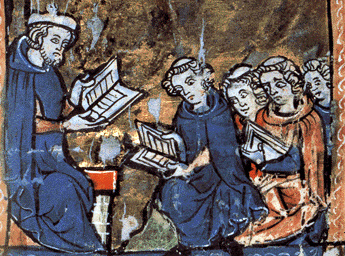Díalógar (Viðræður) Gregors páfa §II, 8
Edited by Tarrin Wills
Drag the words in the Old Norse text onto the corresponding words in the translation (this won’t work if a translation has not been entered into the database).
|
|
Þa es heilagr maþr førþi bvɢþ sina, þa matti hann eigi of fløia fianda gagnstoþo, þvi at en forni andscoti gec siþan meirr i berhogg viþ hann i aþr. Þorp heitir Cassinom, þat er stendr i fialli þar er Norþmenn calla Montacassin, en þar es .iii. milna for af iomno til þorpsins, en þar stoþ fornt hof, þat er blotinn var diofoll sa es callaþr vas solar áss, oc voro þar umbhverfis þeir staþir, es allt þangat til hofþo heiþnir menn blotit. En er Benedictus com þangat, þa braut hann scurþgoþit oc brende blotviþo umhverfis oc górþi or hofino kircio oc helgaþi Martino. En þar er scurþgoþit hafþi staþit, þar let hann gora Jons altare, oc snóri hann til tru retrar i kenningo sinni aullom lvþ et nesta, oc hurfo margir til munca atferþar oc górþosc lerisveinar hans. En en forni fiande ofundi þat oc gegg opt i berhogg viþ hann oc leitaþi viþ at scelfa hann i hreþiligom sionhverfingom oc ogorligom rodom. En gvþs maþr hafþi þvi dvrligra sigr, sem fiandinn gørþi honom fleri þravtir.
|
[¤]When the holy man moved his residence, [¤] he could not [¤] entice the enemy away, [¤] because the old adversary went into conflict then further against him than before. That village is called Cassino which stands on the mountain [¤] which Norwegians call Montacassin, and it is three miles’ journey from the plains to the village, and there stood an old temple, [¤] where the devil was worshipped [sacrificed], the one who was called the god of the sun, and all around there were those places where heathen men had sacrificed everything to him(?). And when Benedict came there, [¤] he destroyed the graven image and burned the sacrificial woods all around and made a church out of the temple and consecrated it to St Martin. And [¤] where the graven image had stood, [¤] he had an alter built to St John and he converted all the remaining people to the true faith in his teachings and many turned to the lifestyle of monks and his disciples did so. But the old enemy envied that and went often into conflict against him and sought [¤] to frighten him with dreadful illusions and frightful tempests. But God’s man had [¤] precious victory, while the enemy created for him more troubles.
|
Díalógar (Viðræður) Gregors páfaStart again
CloseTeaching text: translation
Here you can test your Old Norse translation skills by connecting words in the Old Norse text with a translation (if a translation has been entered into the database).
Drag with your finger or mouse the words in Old Norse onto the corresponding words in the English translation. If you are correct, the word will stay and the Old Norse word will be highlighted. If you don’t match the words correctly, the Old Norse word will return to its old position.
Note that translations are subjective and there is never a full word-to-word correspondence between the text and translation. If you notice any mistakes in the site, email the database editor. Where a word in the Old Norse cannot been translated directly ‘[...]’ will appear in the translation and corresponds to the untranslated word. Some Old Norse words will have been translated with more than one English word — these appear together in the same box.
